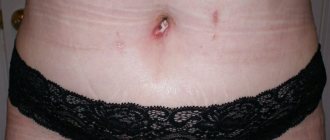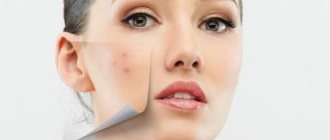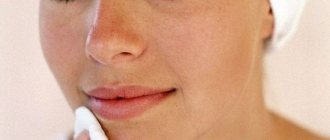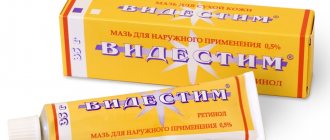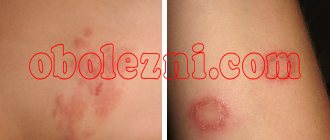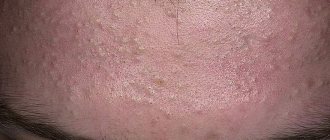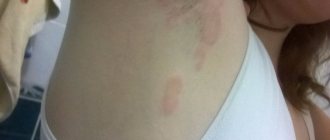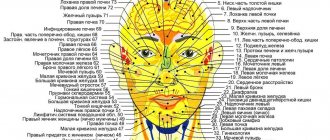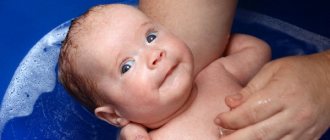A rash on the face is an inflammation of the sebaceous glands. They secrete a special secretion – sebum. Ideally, this is a balanced mixture of various substances produced by the body - fatty acids, steroids, cholesterol, epithelial particles. This “lubricant” protects the surface of the skin from harmful bacteria and serves as an ideal nutritional microflora for it.
Deterioration in the functioning of organs provokes changes in the qualitative and quantitative composition of the secretion and contributes to disruption of its outflow. Sebum goes from being a skin protector to becoming a source of infection. And on the face there is the largest number of sebaceous glands (up to 900 in one square centimeter). The largest of them are located in the area of the forehead, chin, cheeks, wings of the nose, and nasolabial folds. It is not surprising that the rash also “loves” these areas.
Among the dermatologist's recommendations regarding effective treatment, there will certainly be a referral to a gastroenterologist. In some cases, the help of an ENT specialist or endocrinologist is also necessary. But restoring normal functioning of the gastrointestinal tract is the first condition for eliminating the rash.
Why does a rash appear on the face of an adult, reasons
There are general reasons, which are suitable for people of both sexes, and narrow ones, which are typical only for people of a certain gender.
Find the answer
Are you having any problem? Enter “Symptom” or “Name of the disease” into the form, press Enter and you will find out all the treatment for this problem or disease.
Development of pathology in men
Men are more often susceptible to various facial skin diseases, for example, acne or demodicosis. The rash acts as an independent disease or can be a symptom of some other disease, and the primary lesion can be localized in a completely different place.
Diagnosing pathology is a complex process; for many, the concept of rash means any redness on the face. But it manifests itself as extensive lesions and small dots.
It often accompanies other diseases, such as acne or any other inflammation.
Speaking in more detail about the causes of rash on the face in adult men, we can identify:
- Increased levels of the hormone testosterone, as a result of acne;
- Erysipelas;
- Streptococcal, fungal and viral infections;
- Chemical burn.
If you find only a rash, you can assume that it is an allergic reaction. To accurately find out the diagnosis, you will need to undergo a full diagnosis and take many tests, these include smears and scrapings.
If you do not start treating it, it will continue to develop and invade new areas, and over time it will turn into a chronic ulcerative lesion.
A rash develops in the fair sex
When various inflammations appear on the face, a person begins to develop various complexes, especially in girls.
The first action for women is to disguise the rash; this can only worsen the situation, moreover, this may be one of the reasons for its appearance.
Other causes are always similar to those presented in men, that is, the lesion is either infectious or allergic.
Doctors note that the cause will be a common deviation from the norm in the gastrointestinal tract. The rash will be localized to a specific area.
During menstruation in girls, various human hormones, estradiol and progesterone, fluctuate greatly. They can influence other important hormones, changing their values.
Those whose value has changed usually cause various inflammations, for example, increased testosterone in a girl will cause acne, redness and rashes.
Another point that can cause all this, and concerns only girls, is the period after childbirth. Doctors explain this by the fact that the immune system drops significantly during the process.
At this point, redness appears on any part of the body, on the face. More often than not, such manifestations pass quickly and do not require attention.
Classification
Rashes inherently have a variety of causes that need to be structured. Urticaria rash occurs as a result of the following diseases:
1. Urticaria:
- autoimmune reaction of the human body;
- due to insect bites;
- allergic reaction to any products;
- contact with chemicals;
- due to taking any medications.
2. Physical urticaria:
- blisters that appear due to changes in temperature (reaction to heat, cold);
- rashes caused by vibration;
- rash caused by ordinary water;
- physical impact on the skin, for example, rubbing with parts of clothing;
- hereditary factors;
- psychogenic reasons.
3. Urticarial vasculitis is a urticaria-like problem.
Urticarial rash can easily be confused with the type of vasculitis of the same name, which occurs due to inflammation in the cells of the walls of blood vessels in the upper layers of the skin. It can be caused by injuries or damage, infection entering the bloodstream, exposure to tight-fitting clothing on the blood vessels, etc. With urticarial vasculitis, dense red or pink rashes appear, in their place hemorrhages or purple, bluish, yellow pigment spots may appear.
In turn, urticaria has such varieties as acute and chronic.
Common types of facial rashes
The rash refers to many appearances, which may appear as a small dot or as a watery blister.
The main distinguishing feature is redness, which is always present. It can completely fill the entire area or be in the form of small dots.
If we talk in more detail about the types, then:
- The simplest type is a stain. It occurs due to inflammation of blood vessels or skin pigmentation, and can be either infectious or allergic.
- Small bump. It occurs on any part of the skin; if you do not squeeze it out and start therapy on time, it disappears without a trace.
- Blister is a common element. It has a watery filling, flows quickly, and disappears without a trace.
- Pustule. The manifestation, which has purulent content, may be a small lesion affecting only the upper layers of the skin. If it is allowed to develop, the entire hair follicle will be affected, which will leave a scar in the future.
Each species is capable of developing and capturing ever larger areas and transforming into more complex forms. An infectious rash ultimately leads to blood poisoning.
A less dangerous consequence is the development of various ulcerative lesions. To avoid all this, you will need to consult a doctor in time.
Stress
If you have rashes due to chronic stress at work or personal
regarding
niah, you need to go to the doctor, he will recommend a sedative. Unfortunately, the nervous system also suffers, becomes unstable and needs to be treated.
When your psychological state levels out, you will notice that fewer acne appears on the upper edge of your cheekbones and throughout your face. In the meantime, treat the skin with whatever the doctor prescribes. Perform various beneficial procedures and remove impurities from the skin.
How to get rid of a rash using pharmaceutical products
To choose a remedy, you must consult a doctor. It is difficult to choose a drug on your own, because some rashes are a manifestation of various dermatitis, which are treated differently.
A diagnosis will be made, on the basis of which treatment will be prescribed.
For mild lesions, simple therapy with various ointments is used. In more complex cases, tablets are used.
Treatment can be directed at 3 main sources:
- If the lesion is infectious, drugs are used that suppress the infection. The causative agent can only be determined in a hospital setting; it will be bacteria, viruses or fungi; more often the rash is caused by various staphylococci.
- If redness is caused by problems in the body, then corticosteroids are used, which suppress inflammation, redness and other consequences.
- It happens that the cause is an irritant. Treatment is symptomatic, the irritant is identified and eliminated. The treatment will include various soothing, healing ointments.
It is difficult to talk about specific drugs; we can say that the simplest ointments will do.
Signs of chronic urticaria
Urticaria manifests itself in such a way that it is difficult to confuse it with an allergic reaction or a regular rash, since its symptoms are more vivid. The chronic type of this dermatological disease is determined by:
- constantly appearing reddish or pink spots;
- the absence of a clearly defined shape and the possibility of migration of spots on the skin;
- swelling of the mucous membrane of the throat and mouth during relapse of the disease;
- general weakness accompanying the appearance of the rash;
- pain in the joints, which intensifies if the rash is intense.
Quite often, during chronic urticaria, the rash goes away on its own after seven (maximum ten) days, but this process can be accelerated by using medications that have anti-inflammatory and antihistamine activity.
You can remove the defect using folk remedies
Since many types of rashes are quite simple, you can try to cure them using traditional medicine. But it is worth remembering that if the effect does not occur within 3-5 days, you will need to consult a doctor.
Such treatment should be aimed at eliminating symptoms; some folk remedies can effectively combat pathogens of skin lesions.
Effective ones include:
- Oak bark in the form of a decoction, applied topically to the affected area;
- Tar soap, they will need to wash regularly;
- Chamomile infusion, which is suitable for rubbing.
Each of the listed remedies has no side effects; they effectively combat the symptoms and the pathogen itself.
They can be used on a regular basis, even after complete recovery.
They are suitable for prevention in people who are prone to skin lesions.
Any folk remedy works better in combination with a traditional one. In between applications of pharmaceutical ointments, you can use a folk remedy for effect.
Diagnostic methods
Even doctors cannot independently exclude or confirm serious diseases without involving specialists or research. If you notice any of the symptoms mentioned above, go to a specialist. If no clear symptoms are observed, proceed sequentially:
- Visit a gastroenterologist. The doctor will check the symptoms and prescribe tests, if necessary: ultrasound of the liver, pancreas and biliary tract, blood test.
- After questioning, the endocrinologist will recommend undergoing an ultrasound of the pelvic organs and adrenal glands, and donating blood for hormonal levels.
- Psychiatrist. Contacting this specialist frightens many patients, because in their imagination they conjure up images of institutions with bars and a straitjacket. Such stereotypes have no relation to modern psychiatry, so do not be afraid to see a psychiatrist to identify abnormalities in the functioning of the nervous system.
- It’s not for nothing that a dermatologist is in last place on the list of visits to doctors, because he can start working only when other doctors have ruled out pathologies of his own profile. You will be required to submit a scraping of the epidermis, a clinical allergy test and blood test.
If abnormalities are detected, you will be prescribed appropriate treatment that will eliminate acne and the causes of its appearance. Follow all doctor's recommendations, even those related to nutrition and lifestyle.
What to do if you have itching
In addition to a simple cosmetic defect, the disease has other symptoms. An accompanying symptom of many rash lesions is itching.
If itching occurs, then it is highly likely that the rash is infectious in nature. You will need to see a doctor immediately.
After establishing the nature of the disease, begin therapy. More often, itchy rashes are associated with herpes, lichen, and erysipelas.
How to get rid of a rash on your face that itches?
In the beginning, if you find yourself with a rash that is very itchy, you can try to relieve the itching symptoms with a corticosteroid such as Advantan.
But it is worth remembering that the medicine is serious, if you use it for other purposes, you may get complications. The corticosteroid acts so that inflammation, itching and other symptoms disappear.
This happens because it inhibits the activity of cells and all processes in them. This drug works better for non-infectious inflammations, usually atopic dermatitis.
Itching can be relieved using the folk remedy propolis. It is familiar to many people, but not everyone knows about its beneficial properties. Its resinous consistency has a strong bactericidal effect.
A bandage containing this substance is applied to the site of the rash. It starts to work quickly. After just 10 minutes you can notice the effect.
If there is no natural honeycomb, you can use a 10% tincture, which is used to wipe the affected areas.
Diagnostics
Diagnostics will help determine why acne appears on the cheekbones. If any of the above symptoms are detected, then you need to go to a specialist. If clear signs are not expressed, you should act sequentially:
- Visit a gastroenterologist. The specialist will palpate the abdomen and check for symptoms. If necessary, procedures such as FGDS, ultrasound of the liver, biliary tract and pancreas, and biochemical blood test may be prescribed.
- Contact an endocrinologist. Doctors usually advise performing an ultrasound of the adrenal glands, pelvic organs, and donating blood.
- Visit to a psychiatrist. This specialist will help identify hidden disorders in the nervous system.
- You should contact a dermatologist last, as he will be able to identify the cause of acne only after visiting other specialists. A scraping of the epidermis, a clinical blood test and allergy tests will be required.
If abnormalities are found during the examination, the doctor will prescribe treatment that will get rid of acne on the cheekbones and cheeks. It is necessary to follow the recommendations of specialists, and the first positive results will soon appear.
The appearance of a rash for other reasons
Its appearance may be a complication or an allergy to antibiotics. This is rare, but can cause severe redness.
Incorrect and uncontrolled use of antibiotics
More often the cause is an allergy, but it does not just appear. Many doctors note that people affected by various immune diseases are intolerant to antibiotics. For example, if you have HIV infection, then the likelihood of an allergy is quite high.
In addition to the rash, there will be other symptoms, the person will notice severe weakness, vomiting, fever, even fever.
If you experience a sudden deterioration in your condition or similar manifestations, you need to immediately call an ambulance. With this development, the rash will be spread throughout the body.
Some people are allergic to antibiotics from birth, so by the time they reach adulthood they know about it. More often than not, everything stops at rashes and redness. Treatment is carried out locally, the drug that caused the allergy is discontinued.
It is difficult to independently diagnose poisoning or an allergy to antibiotics; many do not think that pills can cause such harm.
Redness after vomiting in a person
If you experience rashes after vomiting, this can mean one thing - poisoning has occurred. The source could be pills or any food ingested within 48 hours.
But in addition to poisoning, in more rare cases, all this can also be caused by ordinary allergies. For example, many people experience red spots after eating an exotic fruit.
Vomiting is an alarming signal, meaning that too much of the allergen has entered the body. Vomiting can be a sign that all the body's systems are overloaded, and redness can mean low immunity.
Treatment is aimed at identifying and eliminating the allergen. They cope with the manifestations of poisoning, the redness goes away on their own.
Recommendations
When acne appears, lifestyle adjustments are necessary. The following tips will help with this:
- Balanced diet. The menu should include vegetables, fruits, and whole grain cereals. Fiber cleanses the intestines, removes waste and toxins.
- Refusal of junk food. You should not eat muffins, confectionery, soda, fast food, or fatty foods. You will also have to give up smoking and drinking alcohol.
- Full sleep. Only with good rest can you have a healthy nervous system and good immunity.
- Prolonged stay in the fresh air. Oxygen is required for redox reactions that occur in the body. Therefore, walking should become a habit.
- Drink 2 liters of warm water every day. You can drink the first glass after waking up.
- Removing makeup after coming home. It is advisable to avoid foundation, concealer, powder and blush. You need to use only high-quality cosmetics and special makeup removers.
- Regular peeling. The procedure will remove dead epidermal cells and open the ducts of the sebaceous glands. You need to use a scrub every week, and perform salon treatments several times a year. Cosmetologists recommend acid peeling and cryodermabrasion.
Facial rash with fever
Rarely is the rash complicated by fever or the rash is a symptom of a primary serious illness.
This often means that there is an infection in the body.
There are several variants of diseases that could do this, here are some of them:
- Rubella;
- The onset of chickenpox;
- Measles;
- Enterovirus infection.
All the diseases presented are quite difficult for adults to tolerate, so treatment consists of hospitalization in an infectious diseases hospital. There, therapy is prescribed that makes it easier to endure the course of the disease.
Many people consider the manifestations of rubella and chickenpox to be “childhood diseases,” but they can seriously ruin the life of an adult.
It is impossible to independently treat rashes that are accompanied by fever, because serious complications can result.
Most viral infections are difficult to treat, and recovery occurs due to the activity of the human immune system.
In the hospital, all actions are aimed at eliminating symptoms, that is, antihistamines are used to relieve itching, and redness is treated with antiseptics to prevent complications.
If you have had an infectious disease, you may still be contagious for some time; it is important to receive hospital treatment.
Recovery from redness and spots always occurs without consequences. The most serious viral infections are not able to leave traces if the points are not squeezed out, but processed.
Rules for caring for problem skin
In addition to selecting a method and means to treat acne on the face, it is necessary to carry out certain hygiene measures.
Proper facial skin care consists of the following rules:
- Do not use ordinary soap, which tightens the skin. This provokes the active work of the sebaceous glands, and more subcutaneous fat is released. There are special products for cleansing problem skin;
- regularly use scrubs or peels. Such procedures renew the skin, remove blackheads;
- To avoid infection when applying a cosmetic product with your hands, it is better to purchase a special brush;
- You should wash with clean water, or better yet, with herbal decoctions. The towel must be individual and used only for the face;
- After cleansing, do not rub the problem skin, just blot it;
- It is not recommended to squeeze out mature pimples, as there is a high risk of bacteria getting into the wound and causing an unsightly scar in the future;
- if the inflammation is very severe, it is better to periodically visit a beauty salon to correct this problem and be sure to consult a dermatologist.
White pustular formations
Another type of rash is small spots with white pus. They will be a manifestation of acne or appear due to hormonal imbalance.
More often they appear due to disorders and problems in the skin. That is, if the sebaceous glands are often clogged, and the skin is naturally oily, then white spots often appear.
The causative agent of this manifestation can be any infection, most often it is staphylococcus or acne bacteria. The presence of pus always means an infection.
This type can be treated quite well. Local antibacterial treatment is sufficient. Ointments and antiseptics are used to stop the development of the disease and suppress pathogenic microflora.
Products that suppress sebum production help, but they are used as a last resort. After successful recovery, preventive measures are taken to prevent the disease from returning.
General recommendations
Acne, the causes of which are not clear, requires lifestyle adjustments . You'll have to give up your favorite buns and reconsider other habits:
- Stick to a balanced diet. Add more fruits, cereals and vegetables to your menu. The fiber contained in these products cleanses the intestines and removes toxins and waste.
- Avoid junk food. From now on, confectionery, baked goods, fast food, fatty foods and carbonated drinks are prohibited for you. Minimize your consumption of alcohol and smoking or give it up altogether.
- Be sure to get enough sleep. Without proper sleep, there can be no talk of a healthy nervous system and a well-functioning immune system.
- Spend more time outdoors. Ventilation and a daily walk should become a habit, because oxygen has a good effect on redox reactions in the body.
- Drink at least two liters of clean water daily. Immediately after waking up, drink one glass to help the body flush out accumulated metabolic products in the tissues.
- When you return home, remove your makeup immediately. If possible, avoid using concealer, blush, foundation and powder. Use high-quality cosmetics and specialized makeup removers.
- Exfoliate regularly to remove dead skin cells and open up the oil glands. Use a scrub once a week and undergo salon treatments several times a year. The cosmetologist will advise you on cryodermabrasion, acid peeling or another technique.
What determines the hormonal background of the body?
Many organs of the human body are responsible for the production of hormones:
- cortex;
- hypothalamus;
- adrenal glands;
- endocrine glands;
- ovaries (in women) and others.
Disturbances in the natural functioning of any of them can provoke an imbalance of hormones, which can cause acne. In almost half of the cases (45%), its development in adults is a symptom of a disorder of the endocrine system.
The main hormones that influence the appearance of acne are:
- testosterone;
- dehydrotestosterone;
- dehydroepiandrosterone;
- insulin-like growth factor-1.
In some cases, fluctuations in hormonal levels in the body are completely natural.
They necessarily occur during the period:
- puberty;
- pregnancy and lactation;
- menopause and menstrual cycle;
- use of certain medications, in particular hormonal contraceptives.
